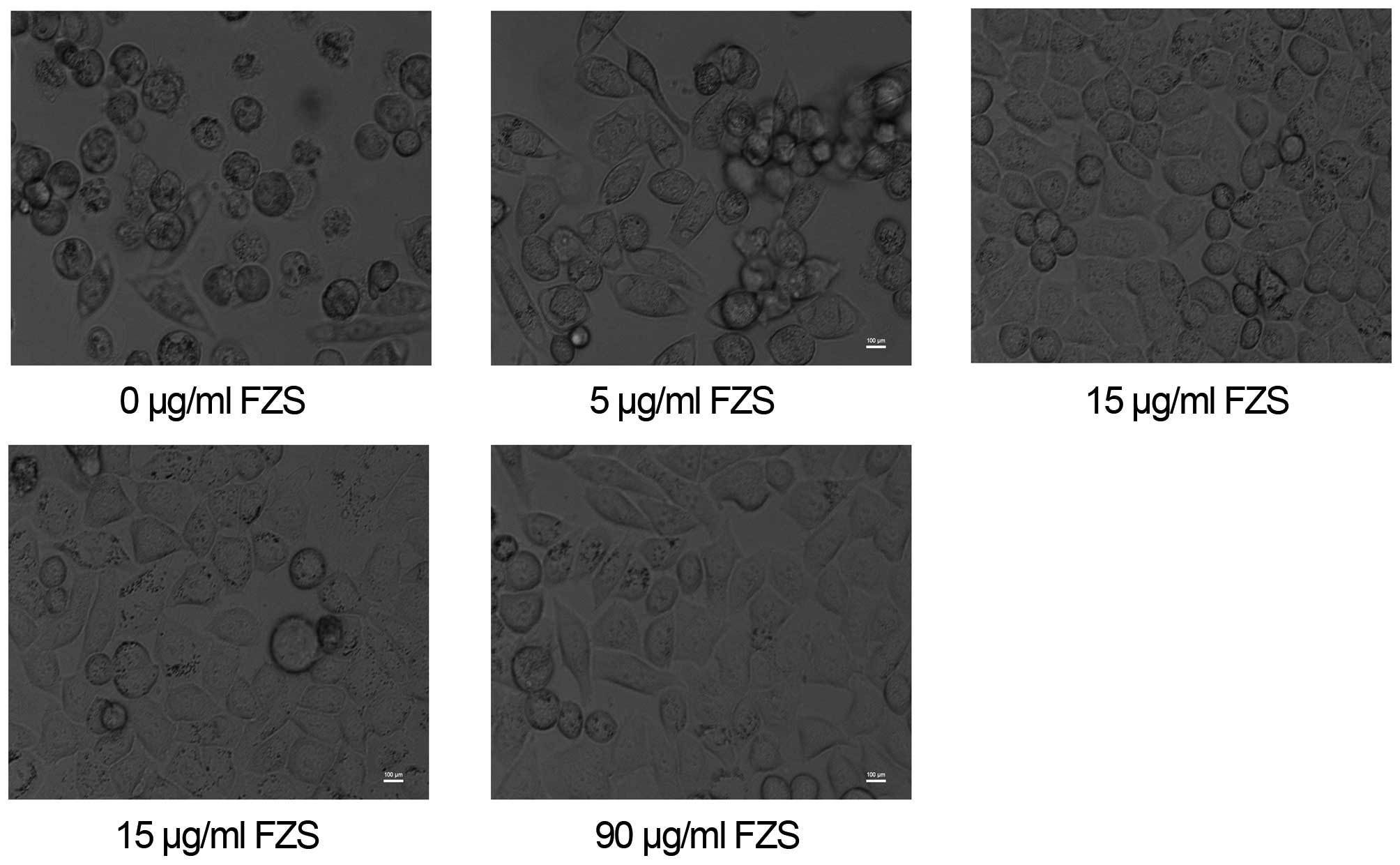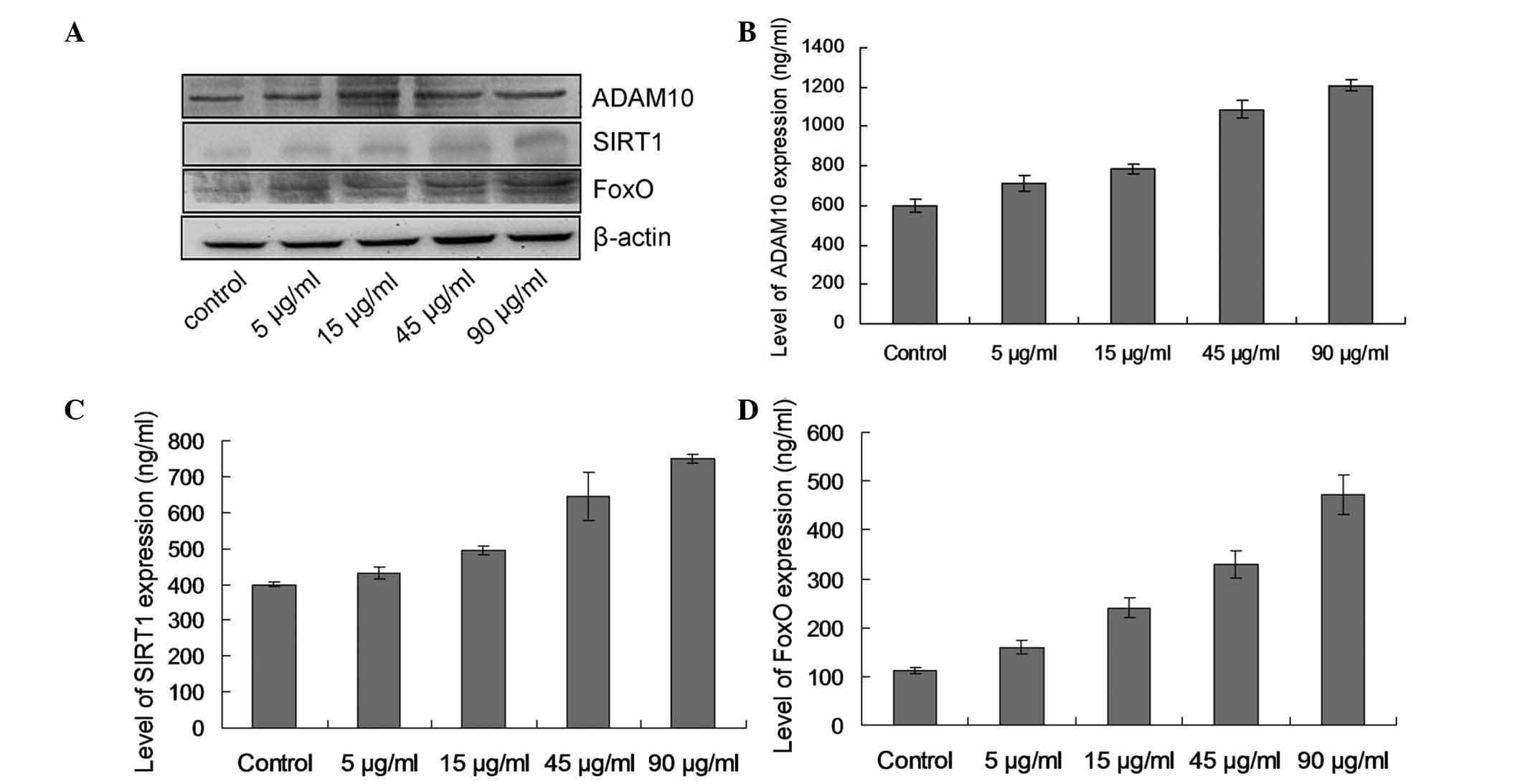|
1
|
Xing S, Shen D, Chen C, Wang J and Yu Z:
Early induction of oxidative stress in a mouse model of Alzheimer's
disease with heme oxygenase activity. Mol Med Rep. 10:599–604.
2014.PubMed/NCBI
|
|
2
|
Ferri CP, Prince M, Brayne C, Brodaty H,
Fratiglioni L, Ganguli M, Hall K, Hasegawa K, Hendrie H, Huang Y,
et al Alzheimer's Disease International: Global prevalence of
dementia: A Delphi consensus study. Lancet. 366:2112–2117. 2005.
View Article : Google Scholar : PubMed/NCBI
|
|
3
|
Walsh DM and Selkoe DJ: Deciphering the
molecular basis of memory failure in Alzheimer's disease. Neuron.
44:181–193. 2004. View Article : Google Scholar : PubMed/NCBI
|
|
4
|
Hardy J and Selkoe DJ: The amyloid
hypothesis of Alzheimer's disease: Progress and problems on the
road to therapeutics. Science. 297:353–356. 2002. View Article : Google Scholar : PubMed/NCBI
|
|
5
|
Tanzi RE and Bertram L: Twenty years of
the Alzheimer's disease amyloid hypothesis: A genetic perspective.
Cell. 120:545–555. 2005. View Article : Google Scholar : PubMed/NCBI
|
|
6
|
Postina R, Schroeder A, Dewachter I, Bohl
J, Schmitt U, Kojro E, Prinzen C, Endres K, Hiemke C, Blessing M,
et al: A disintegrin-metalloproteinase prevents amyloid plaque
formation and hippocampal defects in an Alzheimer's disease mouse
model. J Clin Invest. 113:1456–1464. 2004. View Article : Google Scholar : PubMed/NCBI
|
|
7
|
De Strooper B: Loss-of-function presenilin
mutations in Alzheimer disease. Talking Point on the role of
presenilin mutations in Alzheimer disease. EMBO Rep. 8:141–146.
2007. View Article : Google Scholar : PubMed/NCBI
|
|
8
|
Kojro E and Fahrenholz F: The
non-amyloidogenic pathway: Structure and function of α-secretases.
Subcell Biochem. 38:105–127. 2005. View Article : Google Scholar
|
|
9
|
Sinclair DA and Guarente L:
Extrachromosomal rDNA circles - a cause of aging in yeast. Cell.
91:1033–1042. 1997. View Article : Google Scholar
|
|
10
|
Chen J, Zhou Y, Mueller-Steiner S, Chen
LF, Kwon H, Yi S, Mucke L and Gan L: SIRT1 protects against
microglia-dependent amyloid-beta toxicity through inhibiting
NF-kappaB signaling. J Biol Chem. 280:40364–40374. 2005. View Article : Google Scholar : PubMed/NCBI
|
|
11
|
Qin W, Yang T, Ho L, Zhao Z, Wang J, Chen
L, Zhao W, Thiyagarajan M, MacGrogan D, Rodgers JT, et al: Neuronal
SIRT1 activation as a novel mechanism underlying the prevention of
Alzheimer disease amyloid neuropathology by calorie restriction. J
Biol Chem. 281:21745–21754. 2006. View Article : Google Scholar : PubMed/NCBI
|
|
12
|
Kim D, Nguyen MD, Dobbin MM, Fischer A,
Sananbenesi F, Rodgers JT, Delalle I, Baur JA, Sui G, Armour SM, et
al: SIRT1 deacetylase protects against neurodegeneration in models
for Alzheimer's disease and amyotrophic lateral sclerosis. EMBO J.
26:3169–3179. 2007. View Article : Google Scholar : PubMed/NCBI
|
|
13
|
Julien C, Tremblay C, Emond V, Lebbadi M,
Salem N Jr, Bennett DA and Calon F: Sirtuin 1 reduction parallels
the accumulation of tau in Alzheimer disease. J Neuropathol Exp
Neurol. 68:48–58. 2009. View Article : Google Scholar
|
|
14
|
Donmez G and Guarente L: Aging and
disease: Connections to sirtuins. Aging Cell. 9:285–290. 2010.
View Article : Google Scholar : PubMed/NCBI
|
|
15
|
Min SW, Cho SH, Zhou Y, Schroeder S,
Haroutunian V, Seeley WW, Huang EJ, Shen Y, Masliah E, Mukherjee C,
et al: Acetylation of tau inhibits its degradation and contributes
to tauopathy. Neuron. 67:953–966. 2010. View Article : Google Scholar : PubMed/NCBI
|
|
16
|
Donmez G: The neurobiology of sirtuins and
their role in neurodegeneration. Trends Pharmacol Sci. 33:494–501.
2012. View Article : Google Scholar : PubMed/NCBI
|
|
17
|
Donmez G, Wang D, Cohen DE and Guarente L:
SIRT1 suppresses beta-amyloid production by activating the
alpha-secretase gene ADAM10. Cell. 142:320–332. 2010. View Article : Google Scholar : PubMed/NCBI
|
|
18
|
Haigis MC and Sinclair DA: Mammalian
sirtuins: Biological insights and disease relevance. Annu Rev
Pathol. 5:253–295. 2010. View Article : Google Scholar : PubMed/NCBI
|
|
19
|
Li XL, Wang S, Zhao BQ, Li Q, Qu HY, Zhang
T, Zhou JP and Sun MJ: Effects of Chinese herbal medicine fuzhisan
on aged rats. Exp Gerontol. 43:853–858. 2008. View Article : Google Scholar : PubMed/NCBI
|
|
20
|
Zhao J, Wang D, Duan S, Wang J, Bai J and
Li W: Analysis of fuzhisan and quantitation of baicalin and
ginsenoside Rb(1) by HPLC-DAD-ELSD. Arch Pharm Res. 32:989–996.
2009. View Article : Google Scholar : PubMed/NCBI
|
|
21
|
Gang BZ and Wang CL: The efficacy of
Fuzhisan in patients with Alzheimer's disease. Chin J Apoplexy Nerv
Dis. 22:527–529. 2005.
|
|
22
|
Wen SR, Wang DS and Zhang JY: Effect of
Fuzhisan on the area of neurosome and the length of axon. Chin J
Clin Rehabil. 9:241–243. 2005.
|
|
23
|
Shirong W, Desheng W and Jingyan Z: The
effect of FZS on the cellular function of SH-SY5Y. J Harbin Med
Univ. 37:383–388. 2003.
|
|
24
|
Sul D, Kim HS, Lee D, Joo SS, Hwang KW and
Park SY: Protective effect of caffeic acid against
beta-amyloid-induced neurotoxicity by the inhibition of calcium
influx and tau phosphorylation. Life Sci. 84:257–262. 2009.
View Article : Google Scholar
|
|
25
|
Hartmann D, Tournoy J, Saftig P, Annaert W
and De Strooper B: Implication of APP secretases in notch
signaling. J Mol Neurosci. 17:171–181. 2001. View Article : Google Scholar
|
|
26
|
Vieira SI, Rebelo S and Domingues SC: da
Cruz e Silva EF and da Cruz e Silva OA. S655 phosphorylation
enhances APP secretory traffic. Mol Cell Biochem. 9:8–17. 2009.
|
|
27
|
Goodman AB: Retinoid receptors,
transporters, and metabolizers as therapeutic targets in late onset
Alzheimer disease. J Cell Physiol. 209:598–603. 2006. View Article : Google Scholar : PubMed/NCBI
|
|
28
|
Costa RM, Drew C and Silva AJ: Notch to
remember. Trends Neurosci. 28:429–435. 2005. View Article : Google Scholar : PubMed/NCBI
|
|
29
|
Corcoran JPT, So PL and Maden M:
Disruption of the retinoid signalling pathway causes a deposition
of amyloid β in the adult rat brain. Eur J Neurosci. 20:896–902.
2004. View Article : Google Scholar : PubMed/NCBI
|
|
30
|
Firestein R, Blander G, Michan S,
Oberdoerffer P, Ogino S, Campbell J, Bhimavarapu A, Luikenhuis S,
de Cabo R, Fuchs C, et al: The SIRT1 deacetylase suppresses
intestinal tumorigenesis and colon cancer growth. PLoS One.
3:e20202008. View Article : Google Scholar : PubMed/NCBI
|
|
31
|
Yoon K and Gaiano N: Notch signaling in
the mammalian central nervous system: Insights from mouse mutants.
Nat Neurosci. 8:709–715. 2005. View
Article : Google Scholar : PubMed/NCBI
|
|
32
|
Patel NV, Gordon MN, Connor KE, Good RA,
Engelman RW, Mason J, Morgan DG, Morgan TE and Finch CE: Caloric
restriction attenuates Abeta-deposition in Alzheimer transgenic
models. Neurobiol Aging. 26:995–1000. 2005. View Article : Google Scholar : PubMed/NCBI
|
|
33
|
Sydow A, Van der Jeugd A, Zheng F, Ahmed
T, Balschun D, Petrova O, Drexler D, Zhou L, Rune G, Mandelkow E,
et al: Tau-induced defects in synaptic plasticity, learning, and
memory are reversible in transgenic mice after switching off the
toxic Tau mutant. J Neurosci. 31:2511–2525. 2011. View Article : Google Scholar : PubMed/NCBI
|
|
34
|
Santacruz K, Lewis J, Spires T, Paulson J,
Kotilinek L, Ingelsson M, Guimaraes A, DeTure M, Ramsden M, McGowan
E, et al: Tau suppression in a neurodegenerative mouse model
improves memory function. Science. 309:476–481. 2005. View Article : Google Scholar : PubMed/NCBI
|
|
35
|
Julien C, Tremblay C, Emond V, Lebbadi M,
Salem N Jr, Bennett DA and Calon F: Sirtuin 1 reduction parallels
the accumulation of tau in Alzheimer disease. J Neuropathol Exp
Neurol. 68:48–58. 2009. View Article : Google Scholar
|
|
36
|
Frescas D, Valenti L and Accili D: Nuclear
trapping of the forkhead transcription factor FoxO1 via
Sirt-dependent deacetylation promotes expression of glucogenetic
genes. J Biol Chem. 280:20589–20595. 2005. View Article : Google Scholar : PubMed/NCBI
|
|
37
|
Brunet A, Sweeney LB, Sturgill JF, Chua
KF, Greer PL, Lin Y, Tran H, Ross SE, Mostoslavsky R, Cohen HY, et
al: Stress-dependent regulation of FOXO transcription factors by
the SIRT1 deacetylase. Science. 303:2011–2015. 2004. View Article : Google Scholar : PubMed/NCBI
|
|
38
|
Giannakou ME and Partridge L: The
interaction between FOXO and SIRT1: Tipping the balance towards
survival. Trends Cell Biol. 14:408–412. 2004. View Article : Google Scholar : PubMed/NCBI
|
|
39
|
Chen X, Huang T, Zhang J, Song J, Chen L
and Zhu Y: Involvement of calpain and p25 of CDK5 pathway in
ginsenoside Rb1's attenuation of beta-amyloid peptide25–35-induced
tau hyperphosphorylation in cortical neurons. Brain Res.
1200:99–106. 2008. View Article : Google Scholar : PubMed/NCBI
|
|
40
|
Lee CH, Kim JM, Kim DH, Park SJ, Liu X,
Cai M, Hong JG, Park JH and Ryu JH: Effects of Sun ginseng on
memory enhancement and hippocampal neurogenesis. Phytother Res.
27:1293–1299. 2013. View Article : Google Scholar
|

















